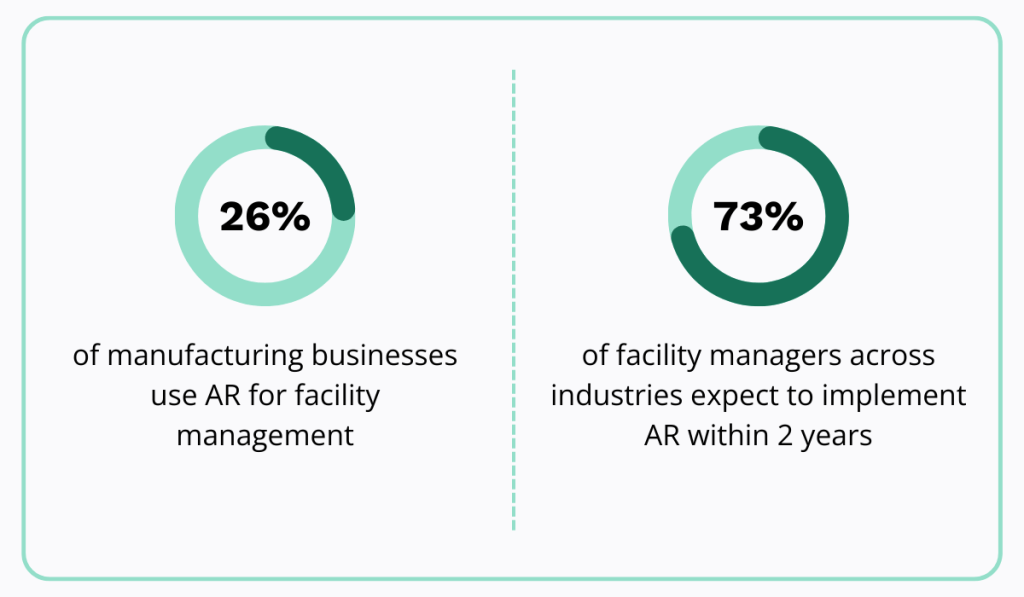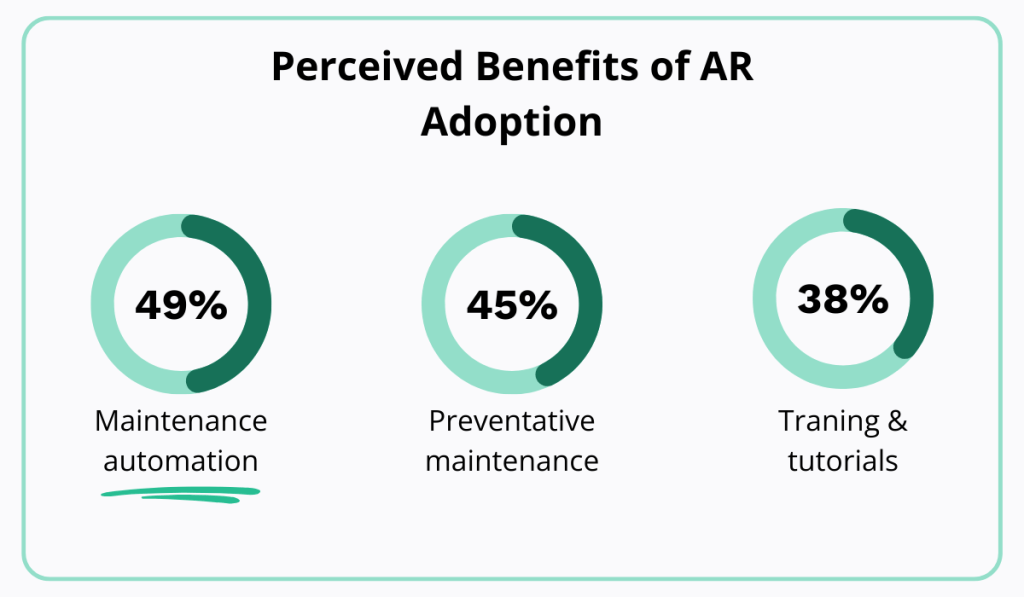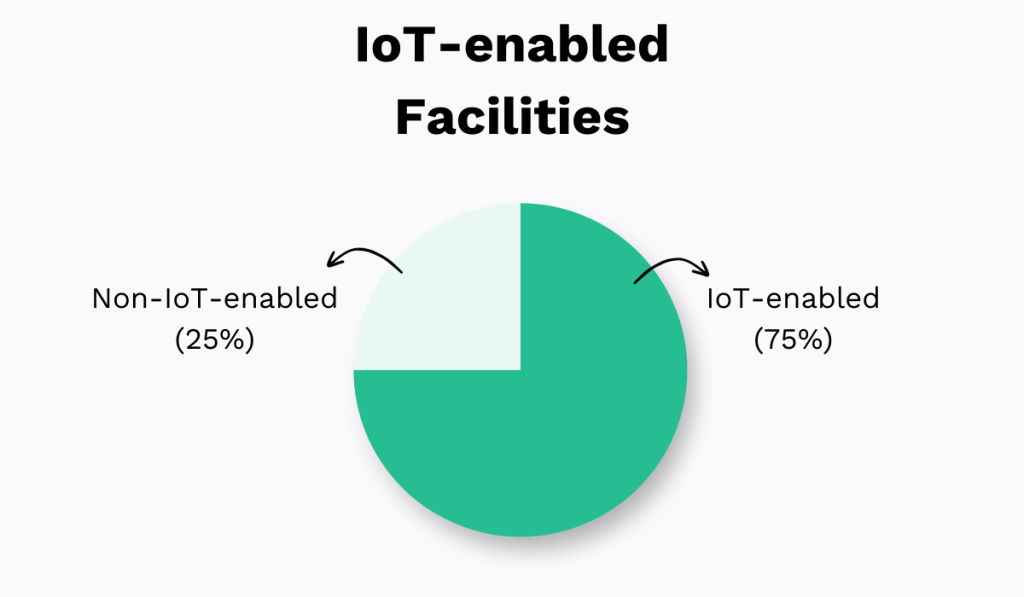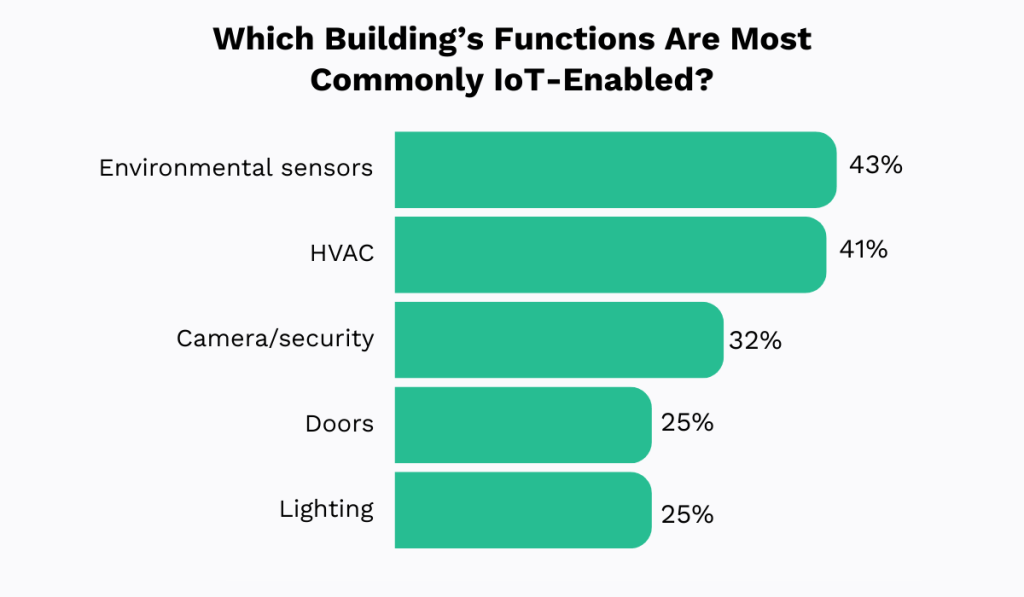Get a Free WorkTrek Demo
Let's show you how WorkTrek can help you optimize your maintenance operation.
Try for freeIn this article, we present 10 key statistics about facility management.
You’ll discover where the industry is headed, the technologies shaping its future, the biggest challenges to overcome, and much more.
By the end, you’ll gain valuable insights into this rapidly evolving field, empowering you to navigate it more strategically and improve your facility management practices.
Let’s get started.
Global Facility Management Market to Reach $2.28 Trillion by 2032
According to Fortune Business Insights, the facilities management market is experiencing strong growth.
Valued at $1.3 trillion in 2024, it’s projected to expand to $2.28 trillion by 2032, with a CAGR of 8.2%.
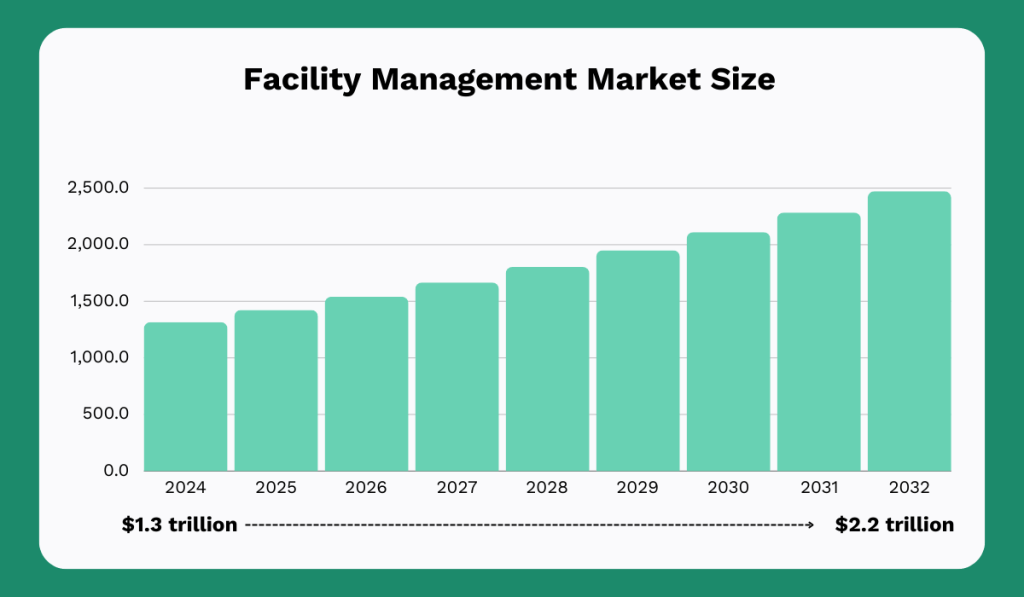
This growth is mainly driven by urbanization and infrastructure developments fueled by a growing population.
More people directly increase demand for new residential complexes, transport networks, and other infrastructures.
Naturally, with every new building comes the need for skilled professionals to manage and maintain it.
That’s where facility management (FM) comes into play.
FM professionals are capitalizing on this increasing need and offering personalized services tailored to all types of buildings.
And, judging by the following statistic, many are already feeling the strain of a growing workload.
55.7% of Facility Managers Expect Higher Work Order Volumes in 2024
The JLL Technologies’ State of Facilities Management Technology Report reveals that managing facilities is increasingly challenging.
Namely, out of 230 FM experts across different countries and industries, 55.7% agreed that they expected an increase in work orders (WOs) in 2024 compared to 2023.
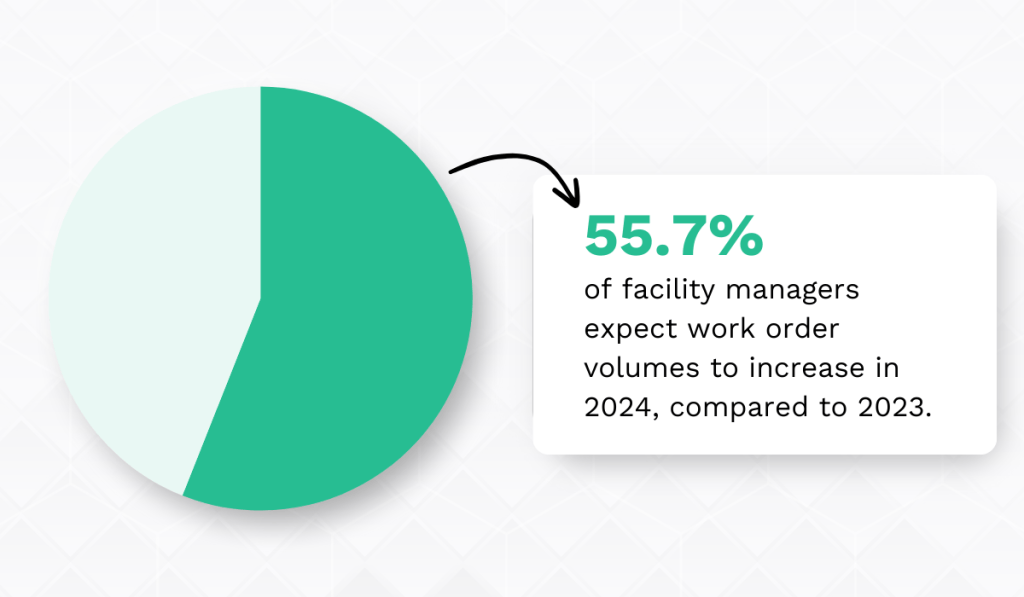
In facility management, work orders are the heart of operations.
They provide detailed instructions on how to perform tasks and are essential to ensuring cost-effective and efficient processes.
However, as work order volumes grow, so does the complexity of managing them.
Below, you’ll find a breakdown of what a streamlined work order process should look like.
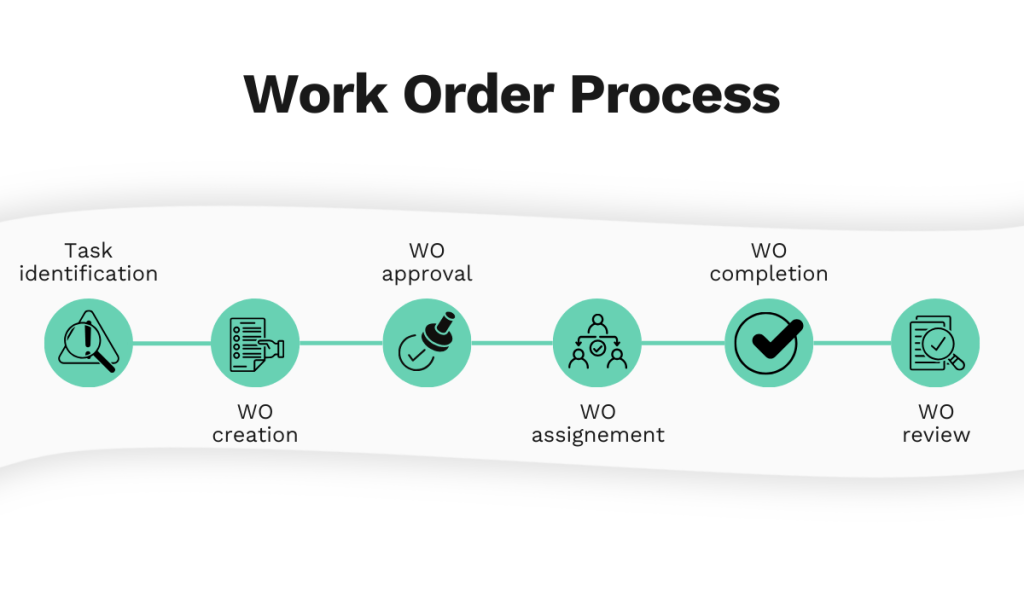
Ideally, each step should be completed quickly and easily.
However, that’s often easier said than done.
Some parts of the WO process are especially challenging for facility managers. Let’s explore which ones.
Work Order Tracking Is Time-Consuming for 44.1% of Facility Managers
FM professionals are bogged down by a wide range of tasks, from invoicing and reporting to assigning WOs and managing warranties.
However, the JLL Technologies survey shows that their most time-consuming activity is tracking the work order status.
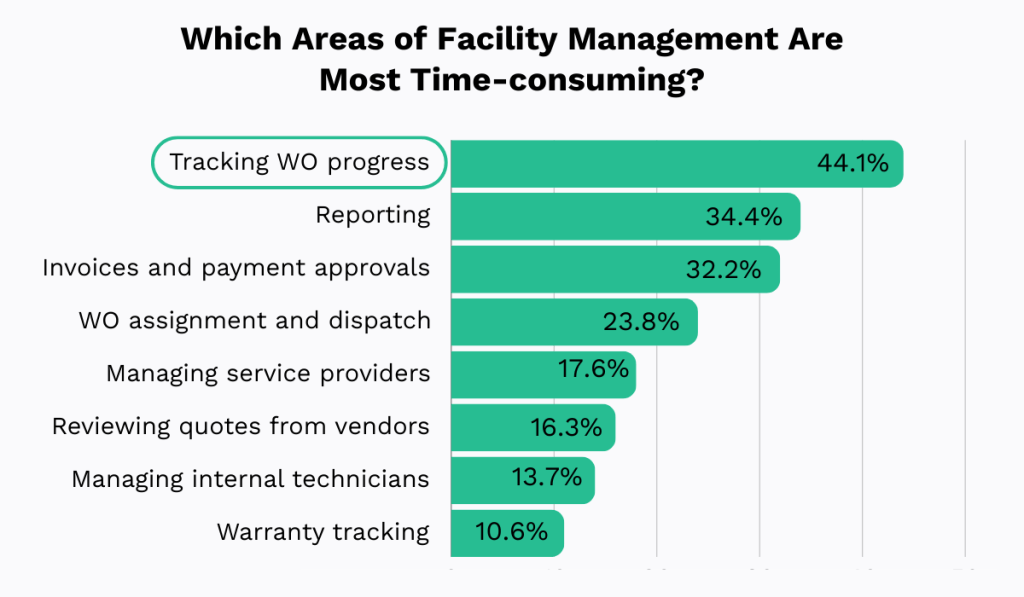
It’s easy to understand why. Tracking who did what, when, and at what cost across multiple work orders simultaneously can significantly drain time and energy.
This is even more challenging when WOs are managed using old-school methods like paper, spreadsheets, and phone calls.
One survey respondent even reported getting up to 60 calls daily from different stakeholders, all checking up on the progress of various WOs.
Just imagine how much time was lost on that one task.
So, one thing is clear: facility managers are facing growing workloads, but the inefficient, cumbersome processes are holding them back.
The big question is: how are they adapting to this issue?
39.6% of Facilities Plan Increased Investment in Facility Management Software
With less staff, more work, and insufficient time to get everything done, over a third of facilities are planning to rely on software.
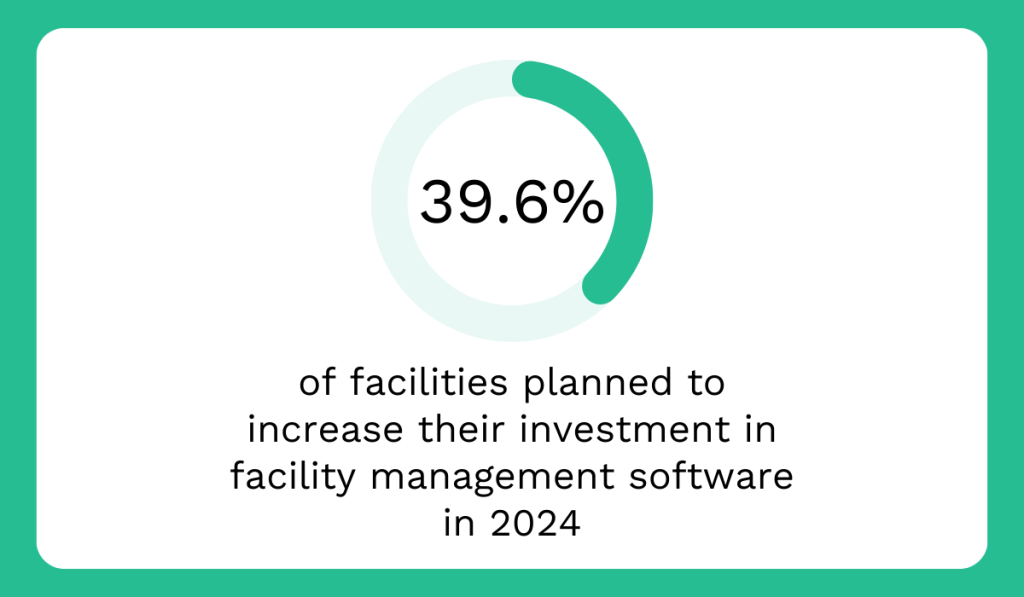
Simply put, many organizations are turning to technology to streamline time-consuming processes and boost productivity.
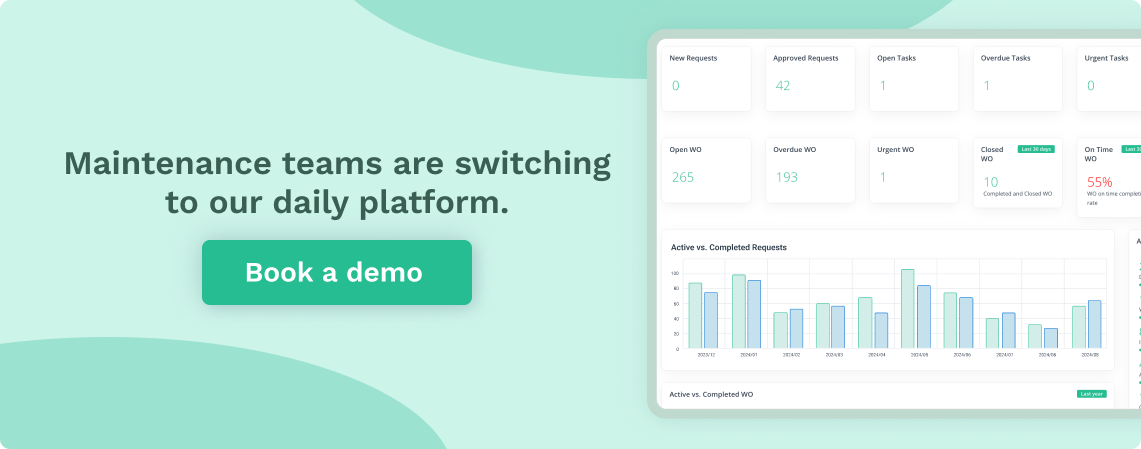
And they’re right to do so.
Facility management software enables users to oversee and control all requests, work orders, and tasks across multiple locations from a single dashboard, whether on a phone or desktop.

This means that the dreaded task of monitoring work order statuses can finally be eliminated. Any authorized employee can easily and quickly look up the information they need in the system.
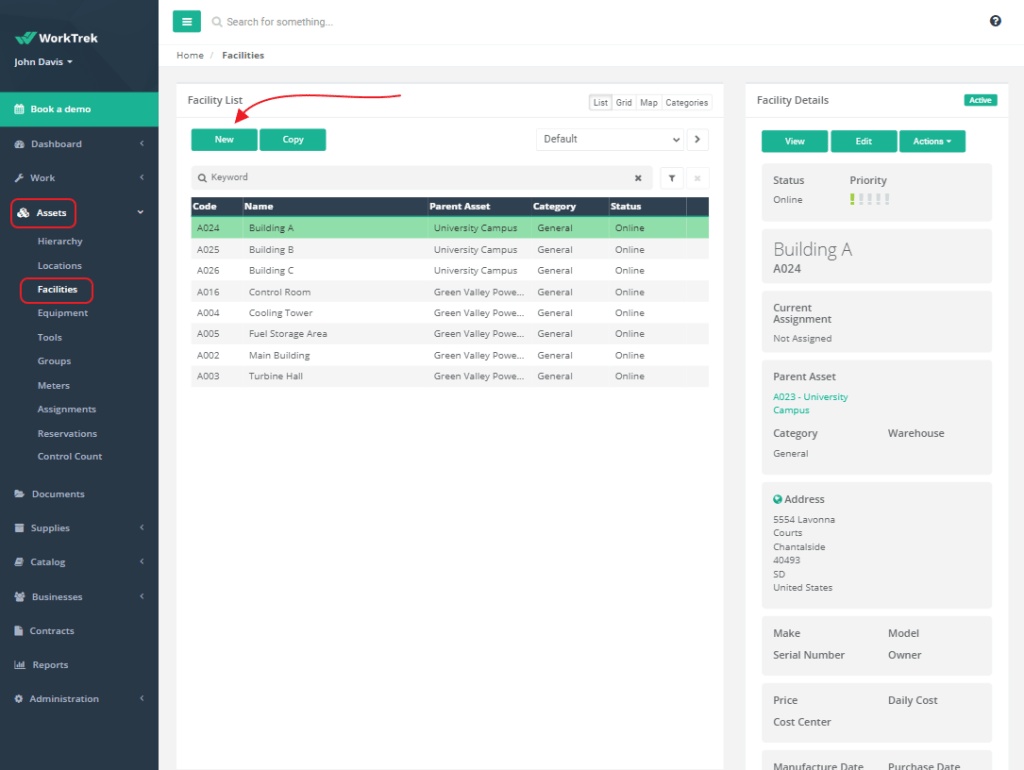
Gordon Food Services, a food distributor in Grand Rapids, Michigan, is a prime example of how much of a game-changer such technology can be.
In 2022, they decided to roll out an FM system that could handle their 190 store locations and integrate all their departments.
Needless to say, they succeeded. According to Kyle McDaniel, their Manager of Construction, Facilities, & Procurement, the biggest win was automating their reporting processes
The biggest thing for an FM operations team is the end of the month, which involves expense reporting and a lot of questions from accounting. We have individual reports and subscriptions that we now automatically produce and send to those folks at the end of the month. So when questions come up, accounting has their reports readily available for answering their own questions.
But this kind of software can do so much more.
It also allows workers to submit requests from anywhere, while managers can assign tasks to specific employees.
Plus, built-in notifications for scheduled service ensure no task falls through the cracks.
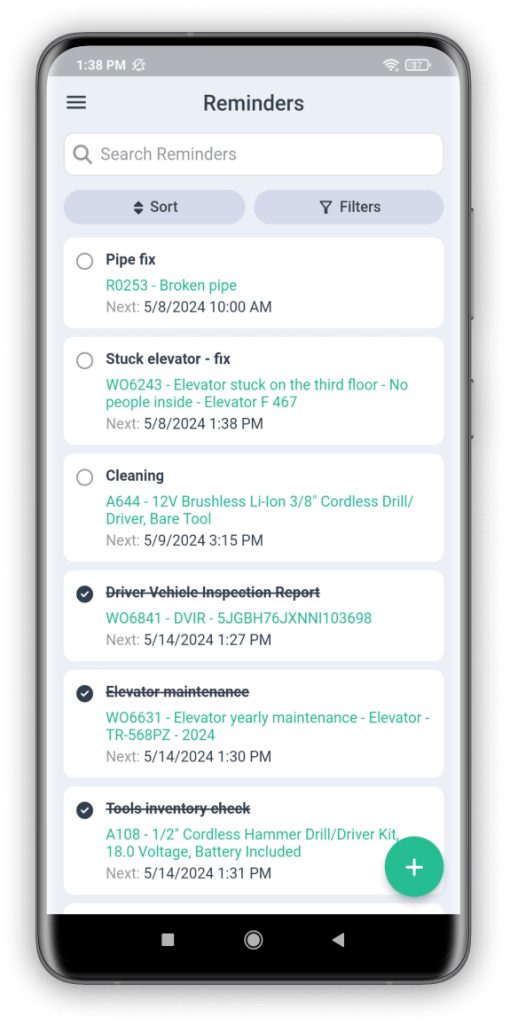
In short, these tools truly make all the difference so it’s not surprising to see increasingly more facilities investing in them.
Now, let’s dive into the specifics and see what they expect to get in return.
27.4% of Facility Managers Expect Work Order Management Software to Automate Repetitive Tasks
The greatest perk of WO management software, according to facility managers, is its ability to streamline processes through automation.
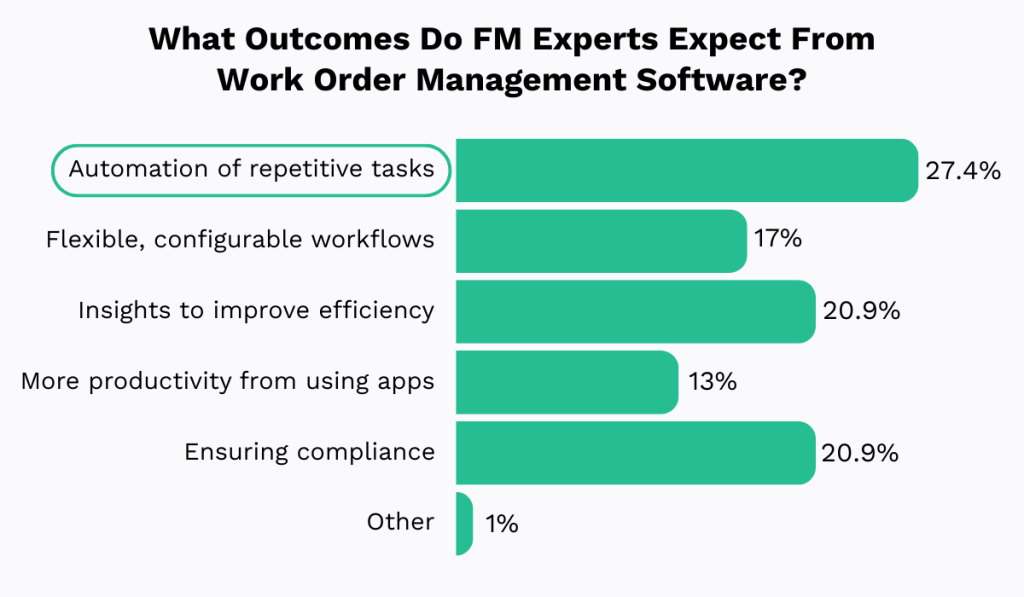
They believe creating or approving work orders, scheduling recurring maintenance, and more can all be handled quickly and efficiently through such solutions.
As a result, operations experience fewer disruptions, and managers get more time to focus on strategic work.
Manual work order management simply can’t compete with these systems.
Manually combing through countless spreadsheets and logbooks to pinpoint maintenance needs while determining who is responsible for what, where, and why is a path to chaos.
This approach only leads to human error, wasted time, and zero visibility.
But, with the WO management system in place, all relevant information is automatically updated and neatly displayed on a dashboard, like the one from WorkTrek software you see below.
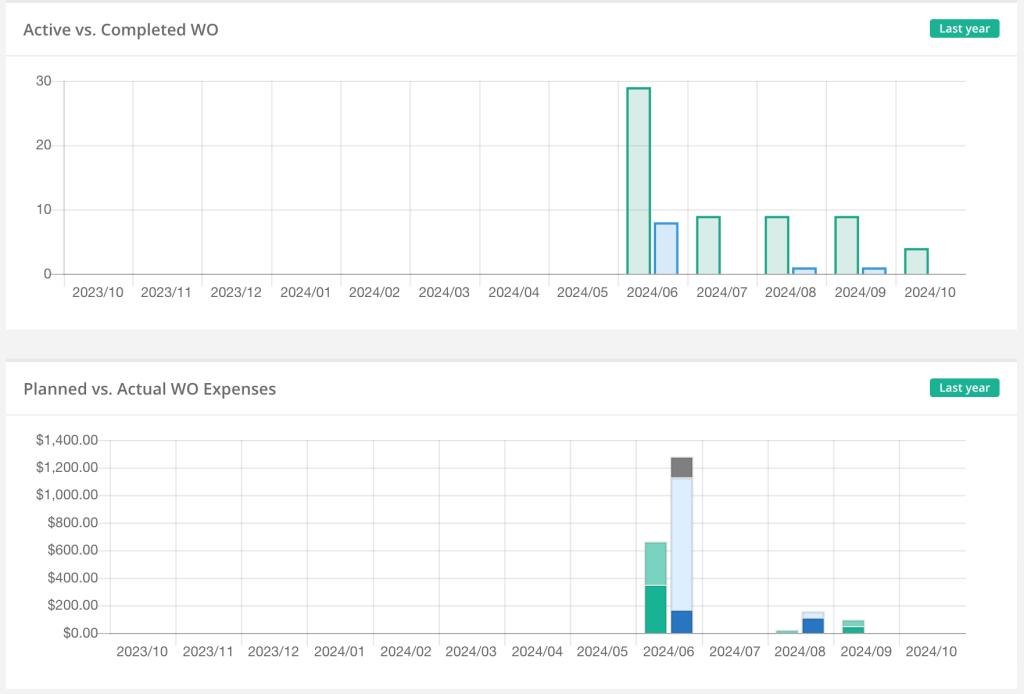
With this software, facility managers finally get the tools to make data-driven decisions quickly and eliminate unnecessary tasks.
And this is just the beginning.
In addition to various software solutions that improve facility management, we’re also witnessing a rise in the use of other advanced technologies.
26% of Manufacturing Facilities Have Adopted AR for Facility Management
Resonai’s 2021 State of Augmented Reality in Facilities Management report reveals that 26% of manufacturing organizations have already implemented augmented reality (AR) for managing their facilities.
Even more striking is that 73% of respondents across all industries expect to adopt this tech within the following two years.
This means that, soon enough, AR could become commonplace in facility management.
AR is a technology that enhances the real world by overlaying audio, video, or graphics on top of it, much like in the example below.
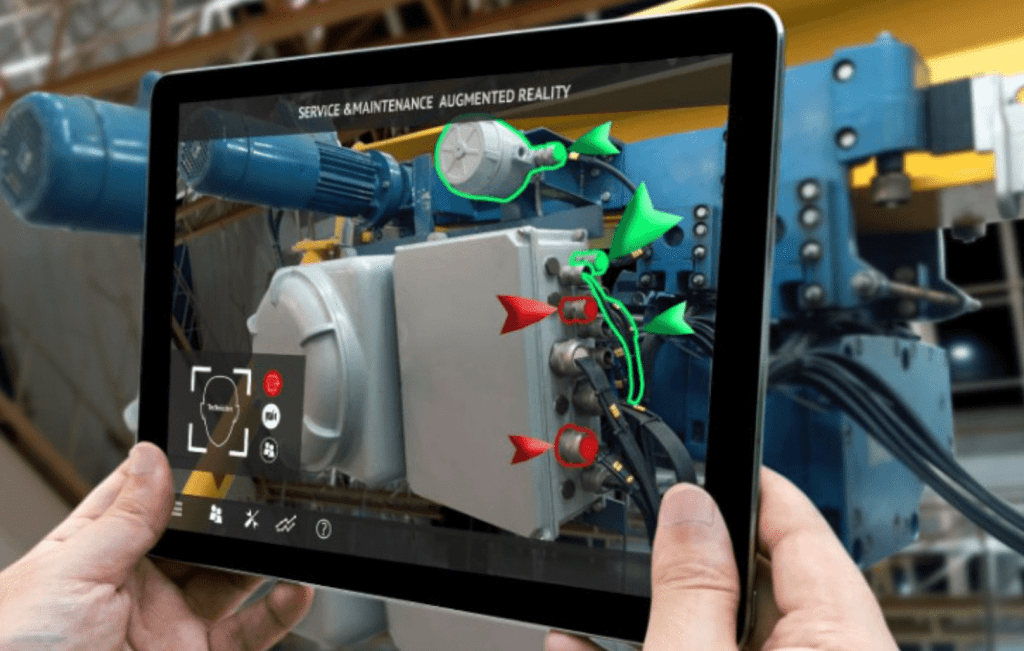
This completely changes how we interact with information, creating a blend of the physical and digital worlds and offering access to real-time data whenever and wherever needed.
49% See Maintenance Automation as the Top AR Benefit
The same survey reveals that nearly half (49%) of facility managers view maintenance automation as the top benefit of AR, followed by preventive maintenance and training.
AR contributes to upkeep automation by improving how technicians interact with equipment and systems, increasing efficiency and accuracy.
One example is guided visual inspections, where AR overlays instructions directly onto assets via smart glasses, tablets, or headsets.
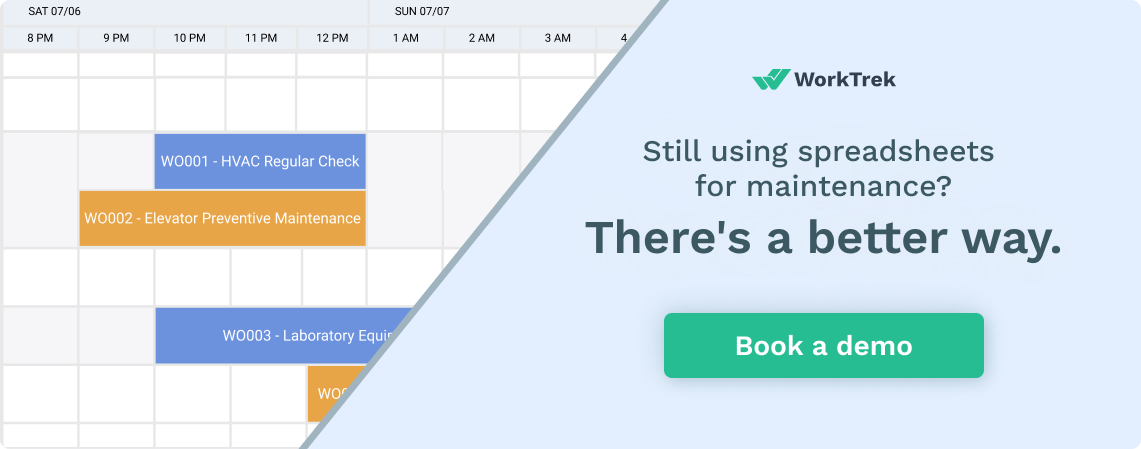
This puts everything a technician needs to know right before their eyes. There is no need to waste time sifting through bulky physical manuals.
As a result, tasks are completed more quickly, in the correct order, and with minimal errors.
Moreover, AR automates access to expert knowledge by enabling real-time remote assistance.
This allows maintenance personnel to share a first-person experience with an expert located anywhere in the world.
The expert can provide guidance, annotate live footage, and even run diagnostics without being present on-site, drastically speeding up the process.
75% of Facility Managers Work With IoT-Enabled Buildings
One major enabler of increasing AR use is the rapid Internet of Things (IoT) adoption in buildings.
In fact, according to the Resonai survey, 75% of facility managers already work in environments equipped with IoT technology.
IoT, which connects everyday objects to the internet for remote access and control, feeds AR with crucial data points like temperature, pressure, vibration, and more.
When this information is layered onto the technician’s field of view in real-time, it can be used for more efficient visualization and diagnostics.
So, which specific functions are most commonly IoT-enabled in modern facilities?
Here are the top five, as per the survey:
From IoT-powered sensors to HVAC systems, cameras, and even doors, our facilities are getting smarter by the day.
And this is revolutionizing facility management as we know it.
42.6% of Facility Management Teams Are Understaffed
All this efficiency-boosting technology can’t come soon enough, as the 2024 JLL Technologies survey reveals that nearly half of facility management teams are currently understaffed.
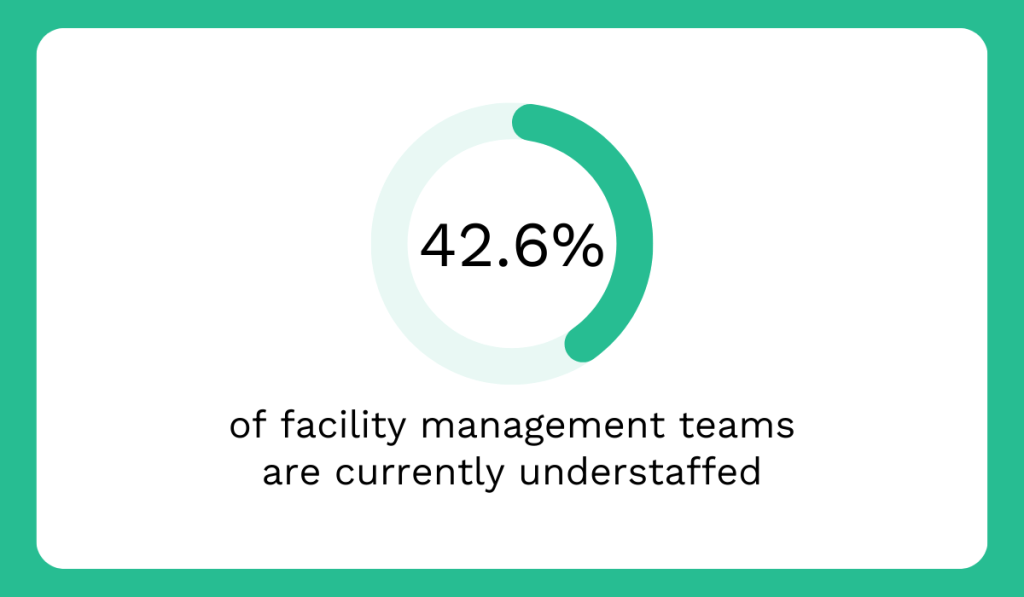
With rising workloads, facility managers find themselves in a tough spot, often forced to do more with less. Unfortunately, there’s no end in sight to these challenges.
Survey respondents highlight many barriers to hiring new staff, with budget constraints topping the list.
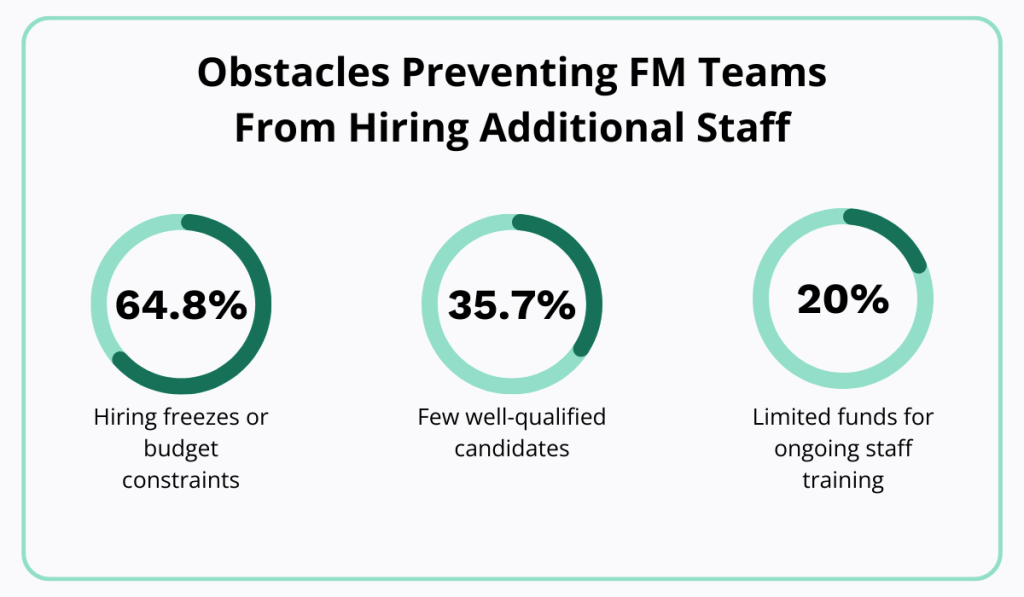
The second biggest challenge is the need for qualified candidates.
As many seasoned professionals retire, the influx of young talent entering the field needs to catch up.
Moreover, to compound these issues, the lack of training funds leaves many facilities struggling to keep up with all the technological advancements in the industry.
As a result, FM teams are pressed to make the most out of minimal resources, with innovative technologies as their only possible lifeline to manage an ever-growing array of tasks.
Women Held 23.4% of Facility Manager Roles in 2023
According to the data from the U.S. Bureau of Labor Statistics, facilities management is still a male-dominated field, with women making up only 23.4% of the workforce.
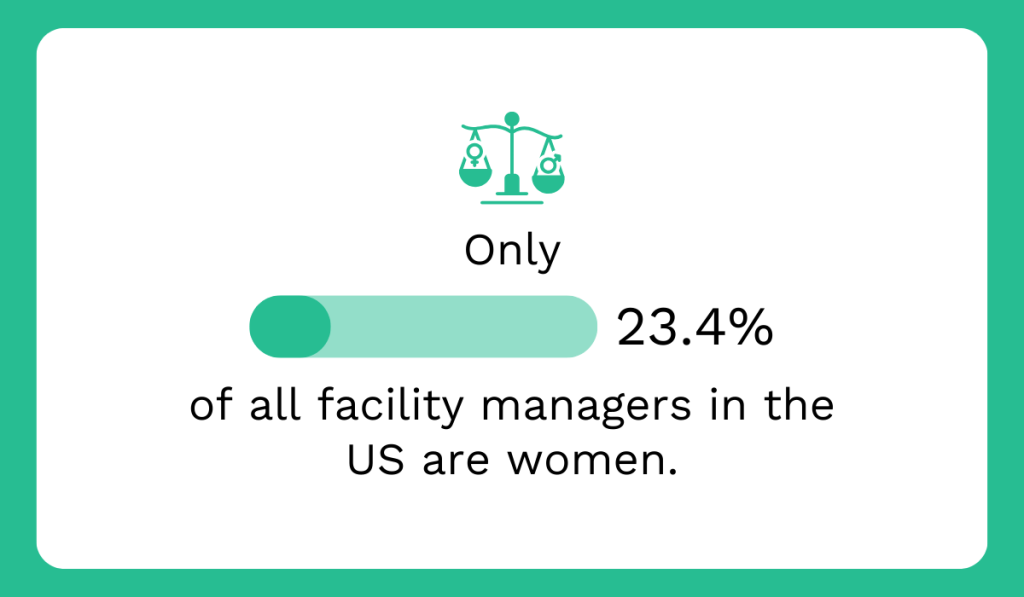
This field, which involves overseeing maintenance, security, and other essential services, has long been viewed as a man’s domain.
An even more discouraging statistic from Zippia shows that this figure has barely budged since 2010, when women made up just 23.5% of facility managers.
Sure, this kind of change never happens overnight, but the pace at which facilities management welcomes women into the field is particularly slow.
Yet, as Danielle J. Floyd, director of public works for Delaware County, Pennsylvania, notes, women have what it takes to excel in these (and other) roles:
I do believe that at the end of the day, it is intrinsically built in us [women] to want to care for and make things better. That deep level of commitment is such a value to have. We just make things work. We weed through the excuses to get the job done. The more that the ‘soft’ skills are valued as equally as the ‘hard’ skills that are required for roles, the more people will take out the extra time to seek out someone who may not have been initially thought of for the position.
Hopefully, we’ll soon see more organizations adopt this mindset and take actions that pave the way for gender equality within the sector.
Conclusion
With its market size expanding yearly and cutting-edge technologies constantly being introduced into the processes, facility management is set to undergo significant transformation over the next decade.
Of course, certain challenges need to be addressed, particularly workforce shortages and gender inequality.
Interestingly, one issue could help solve the other.
By creating a more inclusive environment for women and encouraging their education and involvement in this field, FMs could tackle both the talent gap and gender disparity in one move.
Significant changes are on the horizon, making facility management a field to watch closely in the coming years.





